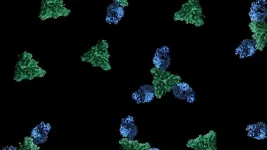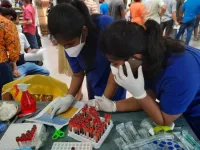(Press-News.org) New York, NY— This week, the State University of New York (SUNY) College of Optometry held a continuation of their annual webinar series, Race in Optometry which started in 2020. Aimed at fostering a national dialogue that leads to necessary changes to increase diversity in the optometric profession and education, the annual webinar focused on Headwinds: Navigating Barriers to Success. This webinar was the seventh installment in a series hosted annually around the Juneteenth holiday by the College’s Office of Continuing Professional Education. Building upon previous themes and actions, each year the conversation evolves to transparently address the progress made as well as current issues.
Dr. Joy Harewood, OD, Director of Diversity, Inclusion, Equity and Belonging at SUNY Optometry, moderated the event. Dr. Harewood noted that it was one year ago that the 6th installment of the webinar series was held on the eve of the monumental SCOTUS decision that struck down racially conscious admissions at most schools. This has been combined with consistent and sustained legislative pressure to dismantle equity, diversity and inclusion initiatives in many aspects of our society, particularly in higher education. “We come together to discuss challenges but also tools and solutions to speak on how we will continue to center equity and inclusion in our profession as we move forward.”
SUNY Optometry President Dr. David A. Heath provided introductory comments and his reflections on four years of important and necessary discussions that have arisen from this webinar series. He went on to introduce the panel’s Keynote Speaker, Dr. John B. King Jr. Chancellor, State University of New York. “On the topic of racial diversity, it’s worth pointing out the tremendous strides SUNY Optometry has made. A decade, or more, of hard work has seen applications from members of underrepresented minorities double, acceptances quadruple, and matriculants triple to about 15% of the Class of 2027.” Chancellor King also pointed out the work across all SUNY schools is ongoing. “DEI is laced throughout everything we do at SUNY because SUNY is an institution of public education focused on opportunity, on upward mobility, on equity, and on removing the broadest to the most niche barriers that prevent marginalized and underrepresented potential students from enrolling and graduating. DEI is one of our four pillars of success adopted as our foundation for our quest for success.”
The power packed panel consisted of leaders from key organizations that support diversity in optometric education and the profession including SUNY College of Optometry (Dr. Guilherme “Gui” Albieri, VP of Student Affairs and Engagement), American Academy of Optometry (Dr. Vondolee Delgado-Nixon, DEIB Committee Chair), Association of Schools and Colleges of Optometry (Dr. Lucy Kehinde Darnell, Diversity and Cultural Competency Committee), Salus University (Dr. Juliana Mosley-Williams, Special Assistant to the President for DEI), Indiana University (Dr. Edwin Marshall, Professor Emeritus – Optometry and Public Health | Past Vice President – Diversity, Equity, and Multicultural Affairs), American Optometric Association (Dr. Curtis A. Ono, Board of Trustees), and National Optometric Association (Dr. Mark Orso, President-Elect).
Addressing changes observed in the past few years and the SCOTUS decision from last year, Dr. Edwin C. Marshall commented, “I am cautiously optimistic. The journey will continue. Just like we saw in 2020, a lot of energy came out of some negative realities, and I think we will see a lot of energy come out of this. Many times, through adversity, we become creative. I think we will need to become more creative in order to deal with those headwinds as we take our journey along that sea of unknowns.”
Wrapping up the conversation was a continued call for accountability with distinct goals and actions as well as identifying the consequences for inaction.
To view past Race in Optometry episodes, visit https://www.sunyopt.edu/academics/programs/continuing-education-ce/special-series/
###
About SUNY Optometry
Founded in 1971 and located in New York City, the State University of New York College of Optometry is a leader in education, research, and patient care, offering the Doctor of Optometry degree as well as MS and Ph.D. degrees in vision science. The College conducts a robust program of basic, translational and clinical research and has 65 affiliated clinical training sites. SUNY Optometry is regionally accredited by the Commission on Higher Education of the Middle States Association of Colleges and Secondary Schools; its four-year professional degree program and residency programs are accredited by the Accreditation Council on Optometric Education of the American Optometric Association. All classrooms, research facilities, and the University Eye Center, which is one of the largest optometric outpatient facilities in the nation, are located on 42nd Street between Fifth and Sixth Avenues in midtown Manhattan. To learn more about SUNY Optometry, visit www.sunyopt.edu.
END
Shared micromobility (including shared electric scooters and bikes provided by private companies) is one of the newest transportation options that has come to cities in the last several decades. A new report explores the different ways cities charge shared micromobility companies to operate, and how these funds are used.
In the newly released report, John MacArthur of Portland State University, Kevin Fang of Sonoma State University and Calvin Thigpen of Lime examine data from 120 cities in 16 countries around the world. They also conducted a survey of cities’ shared micromobility ...
The Ecological Society of America (ESA) presents a roundup of four research articles recently published across its six esteemed journals. Widely recognized for fostering innovation and advancing ecological knowledge, ESA’s journals consistently feature illuminating and impactful studies. This compilation of papers explores the potential for pines to establish in pine-free interior Alaska, internet sleuthing to assess birds’ extinction risk and more, showcasing the Society’s commitment to promoting cutting-edge research that furthers our understanding ...
A year of treatment with a medicine made of an antibody and chemotherapy drug has proven highly effective in preventing stage 1 HER2-positive breast cancer from recurring in patients, a team led by Dana-Farber Cancer Institute researchers has found.
In a clinical trial involving 512 patients with the earliest stage of breast cancer that tested positive for the HER2 protein, 97% of those treated with trastuzumab emtansine (T-DM1) after surgery were alive and free of invasive cancer five years after treatment. The results, published online today in the Journal of Clinical Oncology, suggest that T-DM1 is a reasonable treatment approach for this stage 1 population, the study authors ...
Ephemeral streams – temporary streams that only flow after rainfall or snowmelt – contribute more than 50% of the flow in downstream river systems and likely have a major influence on water quality across the United States, according to a new modeling study. The findings show how important ephemeral streams are for the transport of water and pollution into larger, more permanent water bodies. Excluding these streams from coverage under the U.S. Clean Water Act, say the authors, would significantly limit federal authority to protect downstream water quality. Ephemeral streams, which flow only in direct response to precipitation and are disconnected from groundwater sources, ...
Thanks to being rapidly entombed in volcanic ash – in a “Pompeii-like” process – Cambrian-age trilobites’ anatomy is more discernable than ever, via exquisitely preserved fossils. The fossils uncovered in Morrocco are reported in a new study that reveals microscopic details including of trilobite appendages and the trilobite digestive system. Trilobites are perhaps the most well-known creatures that lived during the Cambrian Period. These extinct marine arthropods’ hard exoskeleton lends itself to high fossilization potential, facilitating the identification of more ...
In a new study in mice, researchers introduce “CHARM,” a compact and versatile epigenetic editor that can be used to silence prion protein throughout the brain. The tool provides a path towards an effective first-line treatment for patients with deadly prion disease as well as other neurodegenerative diseases caused by the toxic buildup of unwanted proteins. Prion disease – a suite of devastating neurodegenerative disorders that result in rapid-onset dementia and death – is caused by misfolding of the prion protein, PrP, to form toxic aggregates that result in neuronal death. Previous research in mice has shown that removing PrP ...
LA JOLLA, CA—What happens when measles virus meets a human cell? The viral machinery unfolds in just the right way to reveal key pieces that let it fuse itself into the host cell membrane.
Once the fusion process is complete, the host cell is a goner. It belongs to the virus now.
Scientists in the La Jolla Institute for Immunology (LJI) Center for Vaccine Innovation are working to develop new measles vaccines and therapeutics that stop this fusion process. The researchers recently harnessed an imaging technique called cryo-electron microscopy to show—in ...
The most obese children with dengue are more than twice as likely as others to be hospitalized with dengue, according to study of 4,782 10- to 18-year-olds in Sri Lanka.
####
Article URL: http://journals.plos.org/plosntds/article?id=10.1371/journal.pntd.0012248
Article Title: Is the rise in childhood obesity rates leading to an increase in hospitalizations due to dengue?
Author Countries: Sri Lanka, United Kingdom
Funding: This study has been supported by the World Health Organization Unity Studies (GNM and CJ), a global sero-epidemiological standardization initiative, with funding to the World Health Organization and the UK Medical Research Council (GSO). The World Health Organization ...
Researchers have described some of the best-preserved three-dimensional trilobite fossils ever discovered. The fossils, which are more than 500 million years old, were collected in the High Atlas of Morocco and are being referred to by scientists as “Pompeii” trilobites due to their remarkable preservation in ash.
The trilobites, from the Cambrian period, have been the subject of research by an international team of scientists, led by Prof Abderrazak El Albani, a geologist based at University of Poitiers and originally from Morocco. The team included Dr Greg Edgecombe, a palaeontologist ...
CAMBRIDGE, MA — Researchers from MIT and the University of Michigan have discovered a new way to drive chemical reactions that could generate a wide variety of compounds with desirable pharmaceutical properties.
These compounds, known as azetidines, are characterized by four-membered rings that include nitrogen. Azetidines have traditionally been much more difficult to synthesize than five-membered nitrogen-containing rings, which are found in many FDA-approved drugs.
The reaction that the researchers used to create azetidines is driven by a photocatalyst that excites the molecules from their ground energy state. Using computational models that they developed, the researchers ...




